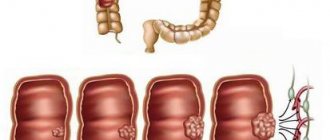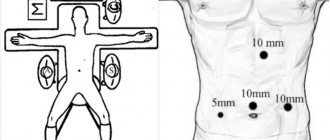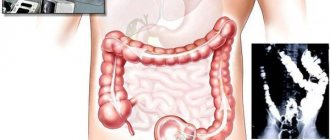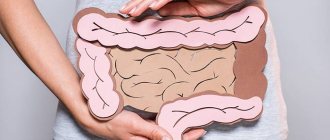Polyps in the gallbladder, treatment with celandine
A universal and affordable treatment for gall polyps is the familiar celandine. Here is this folk recipe:
- prepare a thermos, 1 tablespoon of crushed dry herb of May celandine;
- pour the grass into a thermos. Pour boiling water (1 cup). Leave for an hour and a half, strain.
Take one or two tablespoons 30 minutes before meals. 3 times a day every day for a month. If necessary, repeat the course of treatment after 10 days.
For gall bladder polyps, you can use this method of treatment with celandine:
- Celandine infusion (prepare as in the previous recipe) 1 tablespoon. And one teaspoon of fresh celandine juice. Add to warm boiled water (2l). Give an enema at night. After fifteen enemas, take a break for 15 days.
- After a break, we make the following composition: - Now three tablespoons of celandine infusion and one tablespoon of juice. Again 15 enemas and a break for 15 days.
- Next again after the break. — Take 4 tablespoons of infusion and 2 tablespoons of celandine juice for 2 liters of water. We do fifteen enemas.
Another method of treating celandine for polyps in the gallbladder:
- mix equal parts celandine herb and chamomile flowers;
- Pour one tablespoon of the mixture with boiling water (200ml);
- leave for 6-8 hours, then strain;
Take a tablespoon half an hour before meals three times a day. The course of treatment is at least a month, if necessary, repeat the course after 10 days.
Advice from grandfather
If polyps are found in the gallbladder or stomach, my grandfather advised:
- take equal parts chamomile flowers and celandine herb;
- Pour 1 tablespoon of the mixture into 1 cup of boiling water;
- leave for 1 hour.
You should drink this mixture 1 tablespoon 3 times a day. 20 minutes before meals for a month. + Drink potato juice every day. 1/3 glass 3 times a day before meals until the condition improves.
Gastrointestinal tract - polyps, treatment with celandine
Pass the young celandine grass through a meat grinder. Squeeze out the juice through several layers of gauze. Mix juice with vodka in a ratio of 50:50. Leave for a day, shaking the container periodically.
For polyps in the gastrointestinal tract, drink 1 teaspoon 30 minutes before meals. The course of treatment is 3–4 months.
You can also use this method of treating polyps in the gastrointestinal tract with celandine. — Pass the leaves and stems of celandine through a meat grinder. Pour the resulting pulp with juice at 70-80° boiled water in a ratio of 1:10.
Leave to cool to room temperature. To treat the gastrointestinal tract, administer the infusion by enema and hold for 1–2 hours. The procedure is carried out once a day every day for 2-3 months.
Treatment with celandine for polyps in the bladder and urethra
All components of this collection, except for celandine, can be purchased at the pharmacy. The full course of treatment is 1-1.5 years. The duration of each course is two months. The break between courses of treatment is 10 days.
Pour two or three tablespoons of the mixture into 0.5 liters of boiling water. Leave in a thermos for 6 hours, strain. Take for polyps in the urethra or bladder. Drink the infusion warm, 2/3 cup three times a day. Half an hour before meals.
The collection itself:
- 1 part wild rosemary (shoots);
- 3 parts each of celandine (grass), bearberry leaves, corn silk;
- 2 parts each of dandelion root, thyme (herb), licorice root;
- also 2 parts each of wintergreen, flax seed, mint (herb), nettle leaves;
- 4 parts – horsetail and 5 parts rose hips.
It is advisable to take sitz baths with celandine while taking the infusion. — Celandine herbs 2 tablespoons per 1 liter of boiling water. Leave in a thermos for 2-3 hours, strain. Take baths once a day for a month for 20 minutes.
It is advisable to collect celandine in early May. Take the tops of plants up to 30 centimeters with flowers. Finely chop the celandine grass and dry at room temperature.
Causes
The reasons for the appearance of polypous growths are still being studied, but an important role in etiopathogenesis is played by:
- hormonal imbalance;
- injuries, including medical procedures (curettage);
- infectious, inflammatory diseases of the genital organs;
- uncontrolled use of oral contraceptives, etc.
Diagnosis of polyps is difficult; often they do not manifest themselves at all, and the disease is asymptomatic. Reasons for examination include excessive discharge (leucorrhoea) and intermenstrual bleeding. The diagnosis is made by ultrasound examination of the uterus. Hysteroscopy is used to identify small polypous growths. If a polyp is detected, treatment is required. Sometimes reverse development of the tumor is observed after conservative therapy. Removal is resorted to if there is no result.
Hysteroscopy is usually used for diagnostic examination and resection of a mass in the uterus. It can also be removed with a laser, but the prices for such a service are higher due to the high cost of the equipment.
There are several theories for the development of cervical and uterine polyps. Most often, a polyp in the uterus appears as a result of hormonal imbalance - this is the most common version of the causes of the pathology. Under the influence of high levels of estrogen, the endometrium of the uterus (inner layer) grows. The endometrium can grow evenly, then hyperplasia appears. In case of uneven growth of the endometrial layer, polyps form in the uterus and cervix. Progesterone deficiency ensures the active growth of benign formations.
The following factors contribute to the appearance and growth of polyps in the cervix and uterus:
- Fibroids and myomas.
- Ovarian dysfunction.
- Polycystic ovary syndrome.
- Endometrial hyperplasia.
- Chronic infection in the genitourinary organs, including sexually transmitted infections and human papillomavirus. During inflammation, there is a sharp increase in the number of leukocytes (immune cells), which, along with the destruction of pathogenic microorganisms, promotes the growth of cells of the inner uterine layer.
- Cervical polyps most often appear after unsuccessful curettage.
- Chronic stress leads to an increase or decrease in hormone levels.
- Vascular obstruction - epithelium grows around a blocked vessel.
- Hereditary factor - polyps of the uterus and cervix are more often formed in those patients whose relatives suffered from polyposis. This category of women should be especially attentive to their health and undergo regular preventive examinations.
- An inactive lifestyle contributes to the appearance of congestion in the pelvic organs, as a result of which the uterus and appendages experience a lack of oxygen, which leads to hormonal imbalance and cell proliferation.
- The drug Tamoxifen is used in the treatment of cancer; it causes hormonal disorders. In some patients, a polyp may form in the cervical canal of the cervix or in the uterus.
Diseases of the endocrine system (diabetes mellitus, thyroid disease, obesity) contribute to the development of polyposis. The endocrine glands function in close connection, so disturbances in one gland lead to a malfunction of the other, in particular in the ovaries, which begin to produce sex hormones at an accelerated pace. In diabetes mellitus, microcirculation is disrupted, cell hypoxia occurs, which contributes to their proliferation and atypical changes. With excess weight, adipose tissue produces estrogens, which provoke an increase in cervical polyps. When ovarian function is disrupted, a large amount of estrogen is synthesized, which is released into the blood constantly (normally, the hormone is produced in the first 14 days of the cycle).
As a result, during menstruation, individual fragments of the endometrium remain in the uterine cavity, rather than exfoliating and coming out. Gradually, connective fibers and vessels grow into these areas. This is how a uterine polyp appears.
Polyp in the rectum
Diagnosis: polyp in the rectum. The doctor said that I face surgery in the future. I decided to try folk remedies. I drank an infusion of herbs three times a day, 1/3 cup before meals. Here is a recipe for a folk remedy with celandine - for a polyp in the rectum:
- celandine (herb) – 3 parts;
- calendula (flowers) – 2 parts;
- Pour 2 tablespoons of the mixture into 0.5 liters of boiling water;
- wrap and leave for 6 hours.
In addition, in the morning (100g) and evening (50g) I did an enema with an infusion of the above herbs. I did all this religiously for a month and a half. During the re-examination, the surgeon did not find any polyps. This remedy helped me in treating a polyp, try it too.
The doctor comments: this recipe belongs to N.N. Staff. The full recipe for this folk remedy for polyps looks like this:
- celandine (herb) – 3 parts;
- meadowsweet (flowers) – 3 parts;
- calendula (flowers) – 2 parts;
- St. John's wort (herb) – 2 parts;
- bodyaga – 1 part;
- agrimony (herb) – 2 parts.
Take 1 tablespoon of the mixture, pour 300 ml of boiling water. Make microenemas from 50 ml of infusion an hour before bedtime.
The procedure for treating polyps with this folk remedy is carried out until cure. At the same time, the Headquarters insists on a mandatory three-day fast before treatment.
Take a third of a glass orally three times a day to treat polyps in the stomach. But there is a significant addition. — You need to carry out 4 courses of 5 days each with a rest of 3–5 days between them.
Prevention against polyps
Today's medicine believes that the prevention of polyps is important for the prevention and development of the disease. A symptom of chronic gastritis provokes the formation of a stomach tumor.
Ways to prevent stomach diseases:
- A balanced diet, the predominance of healthy foods on the menu.
- Limit the consumption of alcoholic beverages and tobacco products.
- Take non-steroidal medications for the stomach with caution.
- Reduce consumption of foods with substitutes and food colorings.
Prevention and timely detection of the disease will help maintain health!
Serum and celandine against polyps in the stomach
My husband is 52 years old and suffered from polyps in his stomach. A folk recipe from M. Akhmedshina helped:
- prepare 3 liters of whey;
- take 1 glass of celandine - dried or freshly cut;
- put it in a gauze bag and dip this bag in the serum;
- place a weight on top so that it does not float up;
- add 1 teaspoon sour cream.
Cover the jar with the contents not with a lid, but with several layers of gauze. And put it in a dark place for 2 weeks. Treatment with this remedy for polyps:
Take half a glass 30 minutes before meals 3 times a day for 1-2 weeks. I wish everyone good health. This is how my husband was cured of polyps in his stomach with celandine.
From the history of the disease
As mentioned above, the term polyp originated in Greece. True, historians disagree about who owns the discovery of this pathology. Some believe that the name of the disease was given by Hippocrates, others attribute its discovery to the ancient Roman surgeon Galen. Still others believe that this term was introduced by the philosopher Celsus. The first description of polyposis was made in 1557. It was later developed and supplemented by Morgagnier in 1765 and Lientod in 1767. In Russian medical sources, the first reports of polyps found in the stomach were made by K.F. Slavyansky in 1865. Doctors themselves often confuse polyps with other neoplasms. For the first time, the correct diagnosis before surgery was made by V.P. Samples based on clinical and radiology data. The first polyp was removed in 1909 by surgeon Wegele. Cancer was diagnosed, but after surgery it turned out that it was an adenomatous polyp.
Polyps in the stomach, folk treatment with celandine
You can use the following folk treatment for polyps in the stomach:
Take 30% aqueous infusion of celandine 3 times a day for five days. Fifteen minutes before meals. Take a break for five days, repeat the course of treatment four times.
Or this folk remedy for polyps in the stomach:
Take 15-60 grams of celandine herb (depending on the patient’s weight). Grind and pour one part of the herb with ten parts of boiling water. 2–3 hours before the procedure, the intestines are cleansed with an enema. After which a medicinal infusion of celandine is administered with an enema, the intestines are cleansed after one hour.
It is necessary to perform 6–10 such procedures. Longer treatment is possible with caution. Since celandine is poisonous and can cause harm to health.
The course of treatment for polyps in the stomach should be repeated twice with a break of a week. The following courses are possible next year for 2-3 years.
Treatment of polyps in the stomach, 2 methods
Recipe:
- fill a 3-liter jar one third with well-chopped celandine herb;
- pour boiling water and leave to steep for 5–6 hours;
- then add water to the original volume and begin the course of treatment.
1. Take 3 times a day 30–40 minutes before meals for five days. Start with a teaspoon and gradually increase the dose each time. The dose of medicine at the end of the fifth day is 100 ml. Repeat the course of treatment 4 times with intervals of 5 days for polyps in the stomach.
2. Take the same as in the first case. But the final portion of the medicine is 1 tablespoon. The course has already lasted ten days and is repeated with a break of 10 days. You need three courses of treatment for polyps in the stomach.
Treatment of polyps in the stomach with herbs
- Take 3 parts of celandine herb;
- 2 parts agrimony herb;
- 2 parts calendula flowers and 3 parts meadowsweet flowers.
Pour 1 tablespoon of the mixture into 1 cup of boiling water. Leave to infuse for five hours, then strain.
Take 30–40 minutes before meals three times a day. Start with 1 teaspoon. And gradually bringing the portion per dose to 1 tablespoon.
Take for ten days. Then take a break for 10 days. And repeat the course of treatment for polyps three times.
Contraindications
Many patients refuse to use medications and prefer to treat polyps in the stomach using traditional medicine, considering them the safest. But this is far from true.
Thus, plants that are used for therapy may not be dried properly. Or the herbs were collected in a non-ecological area, for example, near highways and industrial facilities.
In addition, it can be difficult to choose the right dosage in each specific case. As a result, the body can accumulate many toxic and poisonous substances that can provoke the growth of polyps. Therefore, traditional medicine is not recommended for use by the following categories of people:
But traditional medicine should also be used carefully in patients who have been diagnosed with other diseases of the gastrointestinal tract. It is especially worth noting that herbs and additional components (dairy products, alcohol, beekeeping products) that can provoke the development of an allergic reaction are used to prepare folk remedies. Therefore, people predisposed to allergies should carry out this therapy only under the supervision of their attending physician.
Thus, it is quite possible to cure or reduce polyps in the stomach using traditional medicine, but provided that they are small in size and do not have the factor of degeneration into a malignant formation. Therefore, such therapy can be started only after diagnosis and consultation with a specialist.
Polyps of the sigmoid and duodenum
I have a good recipe for a folk remedy for polyps in the intestines. I used it myself 24 years ago. The doctors' diagnosis is a polyp in the sigmoid colon. - 2 mm high, on a fairly wide base, pink in color.
In the book I read a recipe on how to cure polyps without surgery using folk remedies. Treatment of polyps with celandine:
You need to do 10 enemas of flowering celandine over 10 days. That is, one enema a day. If your weight is 70 kg, you will need 70 g of celandine. Which must be brewed in 0.7 liters of boiling water. While it is brewing, do a cleansing enema. After 40 minutes, do the treatment.
But you will need not a syringe, but a dropper of about 1 liter. The infusion should enter the intestines within an hour. - Don’t pour out in a stream, but drip so that the celandine is absorbed.
Lie on your left side and heal for your health. With these enemas I got rid of the polyp without surgery.
Polyps in the colon
1–1.5 hours before the procedure, you need to cleanse your stomach with a regular enema. The treatment is divided into three stages.
- First stage of treatment. Add one teaspoon of celandine juice to one liter of water and do an enema. Treatment is carried out for 10-20 days. Then take a break for 2-3 weeks.
- The second stage of treatment, which also lasts 10-20 days. Apply a solution prepared from 1 tablespoon per 1 liter of water. Again they take a break for 2 weeks.
- At the third stage, treatment for polyps in the colon is similar to the second stage.
After 4 months, repeat the course.
Polyps in the rectum, enemas with celandine
I got rid of polyps in the rectum using a folk recipe. There were many polyps, some were already bleeding. The surgeon said: “Like mushrooms in a clearing. No problem, we’ll pluck it and that’s it.” But my attending physician suggested first trying to do enemas with celandine, here is the recipe:
- poured 1 teaspoon of celandine herb with a glass of boiling water;
- boiled for one minute, left for 20 minutes, then filtered;
- I added 1 teaspoon of fish oil and 30 drops of valerian to this infusion.
The doctor herself gave me a deep enema. I lay on the couch for about half an hour. For 10 days these procedures were daily. After checking, it turned out that all the polyps had disappeared. There was no surgery.
Symptoms
The clinical picture depends on the size of the polyps, their number, variety, and location. Often neoplasms do not make themselves known for a long time. A person discovers a problem in an advanced stage. The most common manifestation is the release of blood along with feces. Frequent urge to have bowel movements and abdominal pain should also alert you. Clinical picture:
Localization of neoplasms
Symptoms
Colon
Rectum
There are no symptoms for a long time, then there is copious discharge of mucus and blood with feces - when the polyps are broken or inflamed
Sigmoid
duodenum
Symptoms appear only with large polyps:
- pain near the navel;
- manifestations of intestinal obstruction;
- rotten belching;
- feeling of fullness in the stomach;
- cramping pain (if the polyp has blocked the intestinal lumen);
- vomit
Small intestine











